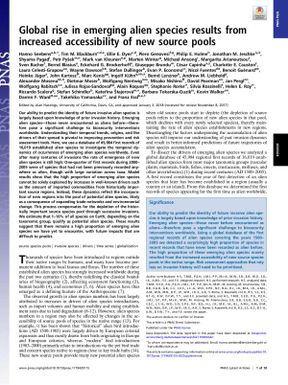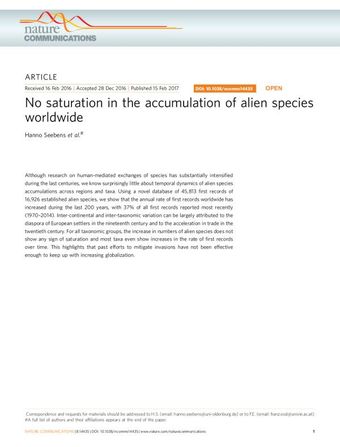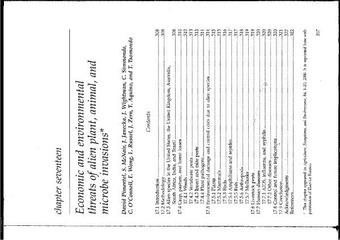Global rise in emerging alien species results form increased accessibility of new source pools
- Description:
- Our ability to predict the identity of future invasive alien species is largely based upon knowledge of prior invasion history. Emerging alien speciesthose never encountered as aliens beforetherefore pose a significant challenge to biosecurity interventions worldwide. Understanding their temporal trends, origins, and the drivers of their spread is pivotal to improving prevention and risk assessment tools. Here, we use a database of 45,984 first records of 16,019 established alien species to investigate the temporal dynamics of occurrences of emerging alien species worldwide. Even after many centuries of invasions the rate of emergence of new alien species is still high: One-quarter of first records during 20002005 were of species that had not been previously recorded anywhere as alien, though with large variation across taxa. Model results show that the high proportion of emerging alien species cannot be solely explained by increases in well-known drivers such as the amount of imported commodities from historically important source regions. Instead, these dynamics reflect the incorporation of new regions into the pool of potential alien species, likely as a consequence of expanding trade networks and environmental change. This process compensates for the depletion of the historically important source species pool through successive invasions. We estimate that 116% of all species on Earth, depending on the taxonomic group, qualify as potential alien species. These results suggest that there remains a high proportion of emerging alien species we have yet to encounter, with future impacts that are difficult to predict.
- Collections:
- Secretariat of the Pacific Regional Environment Programme (SPREP)
- Content partner:
- Secretariat of the Pacific Regional Environment Programme (SPREP)
- Availability:
- Not specified
-
Copyright status: All rights reservedFind out more about what you are able to do with this itemThis item is all rights reserved, with means you'll have to get permission from Secretariat of the Pacific Regional Environment Programme (SPREP) before using it. For more information, please see our use and reuse page.What can I do with this item?Non-infringing useNZ copyright law does not prevent every use of a copyright work, and this item may be hosted by an international institute or organisation. You should consider what you can and cannot do with a copyright work.No sharingYou may not copy and/or share this item with others without further permission. This includes posting it on your blog, using it in a presentation, or any other public use.No modifyingYou are not allowed to adapt or remix this item into any other works.No commercial useYou may not use this item commercially.
Related items
Welcome and warm Pasifik greetings
The information on this site has been gathered from our content partners.
The names, terms, and labels that we present on the site may contain images or voices of deceased persons and may also reflect the bias, norms, and perspective of the period of time in which they were created. We accept that these may not be appropriate today.
If you have any concerns or questions about an item, please contact us.



